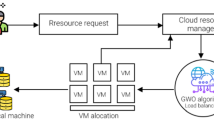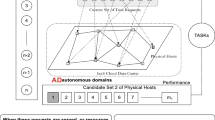Abstract
In recent years, cloud computing provides a spectacular platform for numerous users with persistent and alternative varying requirements. In the cloud environment, security and service availability are the two most significant factors during the data encryption process. For providing optimal service availability, it is necessary to establish a load balancing technique that is capable of balancing the request from diverse nodes present in the cloud. This paper aims in establishing a dynamic load balancing technique using the APMG approach. Here in this paper, we integrated adaptive neuro-fuzzy interference system-polynomial neural network as well as memory-based grey wolf optimization algorithm for optimal load balancing. The memory-based grey wolf optimization algorithm is employed to enhance the precision of ANFIS-PNN and to maximize the locations of the membership functions respectively. Also, two significant factors namely the turnaround time and CPU utilization involved in optimal load balancing scheme are evaluated. Finally, the performance evaluation of the proposed MG-ANFIS based dynamic load balancing approach is compared with various other load balancing approaches to determine the system performances.












Similar content being viewed by others
Availability of Data and Material
Data sharing is not applicable to this article as no new data were created or analyzed in this study.
Code availability
Not applicable.
References
Gupta, A., Bhadauria, H. S., & Singh, A. (2020). SLA-aware load balancing using risk management framework in cloud. Journal of Ambient Intelligence and Humanized Computing. https://doi.org/10.1007/s12652-020-02458-1.
Kong, L., Mapetu, J. P. B., & Chen, Z. (2020). Heuristic load balancing based zero imbalance mechanism in cloud computing. Journal of Grid Computing, 18(1), 123–148.
Kaur, N., Singh, J., Goyal, S., & Duhan, B. (2020). Load balancing in cloud computing: The online traffic management. Journal of Natural Remedies, 21(2), 202–209.
Jyoti, A., & Shrimali, M. (2020). Dynamic provisioning of resources based on load balancing and service broker policy in cloud computing. Cluster Computing, 23(1), 377–395.
Mukhopadhyay, B., Bose, R., & Roy, S. (2020). A novel approach to load balancing and cloud computing security using SSL in IaaS environment. International Journal. https://doi.org/10.30534/ijatcse/2020/221922020.
Tiwari, P. K., Rani, G., Jain, T., Mundra, A., & Gupta, R. K. (2020). Load balancing in cloud computing: Challenges and management techniques. In Critical Approaches to Information Retrieval Research (pp. 294–316). IGI Global.
Ullah, A., Nawi, N. M., & Khan, M. H. (2020). BAT algorithm used for load balancing purpose in cloud computing: An overview. International Journal of High Performance Computing and Networking, 16(1), 43–54.
Naresh, A., Pavani, V., Chowdary, M. M., & Narayana, V. L. (2020). Energy consumption reduction in cloud environment by balancing cloud user load. Journal of Critical Reviews, 7(7), 1003–1010.
Arulkumar, V., & Bhalaji, N. (2020). Performance analysis of nature inspired load balancing algorithm in cloud environment. Journal of Ambient Intelligence and Humanized Computing. https://doi.org/10.1007/s12652-019-01655-x.
Ravikumar, S., Chandrasekaran, S., & Ramesh, S. (2016). Safety assessment of distributed automotive software system model with design for traceability. Asian Journal of Information Technology, 15(11), 1799–1815.
Ravikumar, S., & Kavitha, D. (2020). IoT based home monitoring system with secure data storage by Keccak–Chaotic sequence in cloud server. Journal of Ambient Intelligence and Humanized Computing, 1–13.
Kavitha, Ravikumar, S. (2021). IOT and context-aware learning-based optimal neural network model for real-time health monitoring. Transactions on Emerging Telecommunications Technologies, 32(1):e4132.
Gowthul Alam, M. M., & Baulkani, S. (2019). Local and global characteristics-based kernel hybridization to increase optimal support vector machine performance for stock market prediction. Knowledge and Information Systems, 60(2), 971–1000.
Gowthul Alam, M. M., & Baulkani, S. (2019). Geometric structure information based multi-objective function to increase fuzzy clustering performance with artificial and real-life data. Soft Computing, 23(4), 1079–1098.
Gowthul Alam, M. M., & Baulkani, S. (2017). Reformulated query-based document retrieval using optimised kernel fuzzy clustering algorithm. International Journal of Business Intelligence and Data Mining, 12(3), 299.
Hassan, B. A. (2020). CSCF: a chaotic sine cosine firefly algorithm for practical application problems. Neural Computing and Applications, 1–20.
Hassan, B. A., & Rashid, T. A. (2020). Datasets on statistical analysis and performance evaluation of backtracking search optimisation algorithm compared with its counterpart algorithms. Data in Brief, 28, 105046.
Hassan, B. A., & Rashid, T. A. (2021). A multidisciplinary ensemble algorithm for clustering heterogeneous datasets. Neural Computing and Applications, 1–24.
Jose, J., Gautam, N., Tiwari, M., Tiwari, T., Suresh, A., Sundararaj, V., Rejeesh, M. R. (2021). An image quality enhancement scheme employing adolescent identity search algorithm in the NSST domain for multimodal medical image fusion. Biomedical Signal Processing and Control, 66, 102480.
Maswood, M. M. S., Rahman, M. R., Alharbi, A. G., & Medhi, D. (2020). A novel strategy to achieve bandwidth cost reduction and load balancing in a cooperative three-layer fog-cloud computing environment. IEEE Access, 8, 113737–113750.
Jena, U. K., Das, P. K., & Kabat, M. R. (2020). Hybridization of meta-heuristic algorithm for load balancing in cloud computing environment. Journal of King Saud University-Computer and Information Sciences. https://doi.org/10.1016/j.jksuci.2020.01.012.
Semmoud, A., Hakem, M., Benmammar, B., & Charr, J. C. (2020). Load balancing in cloud computing environments based on adaptive starvation threshold. Concurrency and Computation: Practice and Experience, 32(11), e5652.
Junaid, M., Sohail, A., Rais, R. N. B., Ahmed, A., Khalid, O., Khan, I. A., et al. (2020). Modeling an optimized approach for load balancing in cloud. IEEE Access, 8, 173208–173226.
Devaraj, A. F. S., Elhoseny, M., Dhanasekaran, S., Lydia, E. L., & Shankar, K. (2020). Hybridization of firefly and improved multi-objective particle swarm optimization algorithm for energy efficient load balancing in cloud computing environments. Journal of Parallel and Distributed Computing, 142, 36–45.
Siddiqui, S., Darbari, M., & Yagyasen, D. (2020). An QPSL queuing model for load balancing in cloud computing. International Journal of e-Collaboration (IJeC), 16(3), 33–48.
Neelima, P., & Reddy, A. R. M. (2020). An efficient load balancing system using adaptive dragonfly algorithm in cloud computing. Cluster Computing. https://doi.org/10.1007/s10586-020-03054-w.
Agarwal, R., Baghel, N., & Khan, M. A. (2020, February). Load balancing in cloud computing using mutation based particle swarm optimization. In 2020 International Conference on Contemporary Computing and Applications (IC3A) (pp. 191–195). IEEE.
Priya, V., Kumar, C. S., & Kannan, R. (2019). Resource scheduling algorithm with load balancing for cloud service provisioning. Applied Soft Computing, 76, 416–424.
Polepally, V., & Chatrapati, K. S. (2019). Dragonfly optimization and constraint measure-based load balancing in cloud computing. Cluster Computing, 22(1), 1099–1111.
Hung, T. C., Hieu, L. N., Hy, P. T., & Phi, N. X. (2019, January). MMSIA: improved max-min scheduling algorithm for load balancing on cloud computing. In Proceedings of the 3rd International Conference on Machine Learning and Soft Computing (pp. 60–64).
Rejeesh, M. R. (2019). Interest point based face recognition using adaptive neuro fuzzy inference system. Multimedia Tools and Application, 78(16), 22691–22710.
Jose, J., Gautam, N., Tiwari, M., Tiwari, T., Suresh, A., Sundararaj, V., & Rejeesh, M. R. (2021). An image quality enhancement scheme employing adolescent identity search algorithm in the NSST domain for multimodal medical image fusion. Biomedical Signal Processing and Control, 66, 102480.
Sundararaj, V. (2016). An efficient threshold prediction scheme for wavelet based ECG signal noise reduction using variable step size firefly algorithm. International Journal of Intelligence and Engineering System, 9(3), 117–126.
Sundararaj, V. (2019). Optimised denoising scheme via opposition-based self-adaptive learning PSO algorithm for wavelet-based ECG signal noise reduction. International Journal of Biomedical Engineering and Technology, 31(4), 325.
Sundararaj, V., Muthukumar, S., & Kumar, R. S. (2018). An optimal cluster formation based energy efficient dynamic scheduling hybrid MAC protocol for heavy traffic load in wireless sensor networks. Computers and Security, 77, 277–288.
Vinu, S. (2019). Optimal task assignment in mobile cloud computing by queue based ant-bee algorithm. Wireless Personal Communications, 104(1), 173–197.
Rejeesh, M. R., & Thejaswini, P. (2020). MOTF: Multi-objective Optimal Trilateral Filtering based partial moving frame algorithm for image denoising. Multimedia Tools and Applications, 79(37), 28411–28430.
Banerjee, S., & Patil, A. (2018, December). ECC based encryption algorithm for lightweight cryptography. In International Conference on Intelligent Systems Design and Applications (pp. 600–609). Springer, Cham.
Rahnama, B., Sari, A., & Ghafour, M. Y. (2016). Countering RSA vulnerabilities and its replacement by ECC: elliptic curve cryptographic scheme for key generation. In Network security attacks and countermeasures (pp. 270–312). IGI Global.
Devi, T. D., Subramani, A., & Anitha, P. (2020). Modified adaptive neuro fuzzy inference system based load balancing for virtual machine with security in cloud computing environment. Journal of Ambient Intelligence and Humanized Computing, 1–8.
Adnan, M. M., Sarkheyli, A., Zain, A. M., & Haron, H. (2015). Fuzzy logic for modeling machining process: A review. Artificial Intelligence Review, 43(3), 345–379.
Ghorbanzadeh, O., Blaschke, T., Aryal, J., & Gholaminia, K. (2020). A new GIS-based technique using an adaptive neuro-fuzzy inference system for land subsidence susceptibility mapping. Journal of Spatial Science, 65(3), 401–418.
Chrysos, G. G., Moschoglou, S., Bouritsas, G., Panagakis, Y., Deng, J., & Zafeiriou, S. (2020). P-nets: Deep Polynomial Neural Networks. In Proceedings of the IEEE/CVF Conference on Computer Vision and Pattern Recognition (pp. 7325–7335).
Abdallah, H. B., Henry, C. J., & Ramanna, S. (2020). 1-Dimensional polynomial neural networks for audio signal related problems. arXiv preprint 2009.04077.
Harandizadeh, H., & Armaghani, D. J. (2021). Prediction of air-overpressure induced by blasting using an ANFIS-PNN model optimized by GA. Applied Soft Computing, 99, 106904.
Gupta, S., & Deep, K. (2020). A memory-based grey wolf optimizer for global optimization tasks. Applied Soft Computing, 93, 106367.
Ramezani, F., Lu, J., & Hussain, F. K. (2014). Task-based system load balancing in cloud computing using particle swarm optimization. International Journal of Parallel Programming, 42(5), 739–754.
Shri, M. L., Devi, E. G., Balusamy, B., Kadry, S., Misra, S., & Odusami, M. (2018, December). A fuzzy based hybrid firefly optimization technique for load balancing in cloud datacenters. In International Conference on Innovations in Bio-Inspired Computing and Applications (pp. 463–473). Springer, Cham.
Funding
Not applicable.
Author information
Authors and Affiliations
Contributions
UC agreed on the content of the study. UC and SS collected all the data for analysis. UC agreed on the methodology. UC and SS completed the analysis based on agreed steps. Results and conclusions are discussed and written together. Both author read and approved the final manuscript.
Corresponding author
Ethics declarations
Conflict of interest
The authors declare that they have no conflict of interest.
Human and animal rights
This article does not contain any studies with human or animal subjects performed by any of the authors.
Informed consent
Informed consent was obtained from all individual participants included in the study.
Consent to participate
Not applicable.
Consent for publication
Not applicable.
Additional information
Publisher's Note
Springer Nature remains neutral with regard to jurisdictional claims in published maps and institutional affiliations.
Rights and permissions
About this article
Cite this article
Chourasia, U., Silakari, S. Adaptive Neuro Fuzzy Interference and PNN Memory Based Grey Wolf Optimization Algorithm for Optimal Load Balancing. Wireless Pers Commun 119, 3293–3318 (2021). https://doi.org/10.1007/s11277-021-08400-8
Accepted:
Published:
Issue Date:
DOI: https://doi.org/10.1007/s11277-021-08400-8




